Mitochondria are known as the powerhouses of the cells, taking in glucose and oxygen and producing energy in return. But this central role in cellular function means when things go awry it can have serious consequences for organ function, particularly in those that demand lots of energy like the heart and brain. Replacing malfunctioning mitochondria with versions taken from healthy cells is shaping as a promising but as yet experimental therapy to treat such conditions, and a new breakthrough brings the technique closer to clinical use.
Known as mitochondrial transplantation, the innovative therapy at the center of this research has shown promise in animal studies as a way rejuvenating tissues affected by mitochondrial dysfunction. It involves grafting tissues or injecting healthy mitochondria into damaged tissues, where they are absorbed by the cells to help them heal, and it has also been applied in rare cases to treat damaged hearts in newborn babies. Its clinical use remains limited, however.
Scientists at ETH Zurich have developed a new method of mitochondrial transplantation they say ensures a high survival rate of cells and offers unparalleled efficiency. The breakthrough hinges on a newfound ability to manipulate organelles, the individual structures within cells, which comes courtesy of a specially-developed cylindrical nanosyringe.
This tiny tool enables the scientists to pierce the membrane of healthy cells, suck up the spherical mitochondria, pierce the membrane of a damaged cell and place the mitochondria in its new home. It does so with the help of laser light to precisely control the syringe's position and pressure regulators that adjust its flow, enabling the transfer of incredibly small volumes of fluid.
This means the procedure is minimally invasive, and in lab tests the transplanted mitochondria were found to have a high survival rate of more than 80 percent. Once in the new cells, the mitochondria were seen to fuse with an existing thread-like network of other mitochondria within around 20 minutes. According to the team, the results suggest the approach has now reached a point of technical feasibility.
"Both the donor and acceptor cells survive this minimally invasive procedure,” said Christoph Gäbelein, lead author of the paper.
The technique could be deployed as a way of treating diseased organs, but may also find use in the realm of anti-aging, rejuvenating stem cells that deteriorate in metabolic activity as we grow older. The scientists also plan to use the technique to study how mitochondria came to be through an evolutionary process called endosymbioses.
“We want to understand the processes that control how different cell compartments cooperate – and we hope to unravel how endosymbioses develop over evolutionary time,” said leader of the study Julia Vorholt.
The research was published in the journal PLOS Biology, while the video below shows the technique in action.
Source: ETH Zurich




